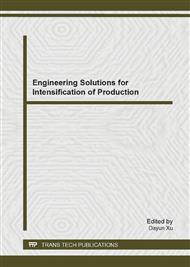p.29
p.33
p.41
p.45
p.52
p.58
p.63
p.66
p.70
Preparation of Microencapsulated Phase Change Materials Using Surface Modification Method
Abstract:
With the adoption of surface modification method, microencapsulated phase change materials (MEPCM) with polyurea as wall materials, paraffin as core materials were successfully prepared. This paper made a research on the effect dosage of modifier might have on the content of microcapsule core materials. Findings indicated that the content of microcapsule core materials was relatively high as the dosage of modifier being core material 10 wt%. It was preliminarily proved that polyurea had been coated on the surface of paraffin particles by adopting Fourier Transform Infrared Spectrum (FTIR) to formulate the composition and structure of microcapsules. And the laser particle analysis declared that particle size distribution of microcapsules was narrow with average particle size of 389 μm. Thermo Gravimetric Analysis (TG) and Differential Scanning Calorimetry (DSC) were also employed to make a representation of the thermal properties of microcapsules, and it was shown that microcapsules were of wonderful phase change performance and thermal stability.
Info:
Periodical:
Pages:
52-57
Citation:
Online since:
February 2014
Authors:
Keywords:
Price:
Сopyright:
© 2014 Trans Tech Publications Ltd. All Rights Reserved
Share:
Citation:


